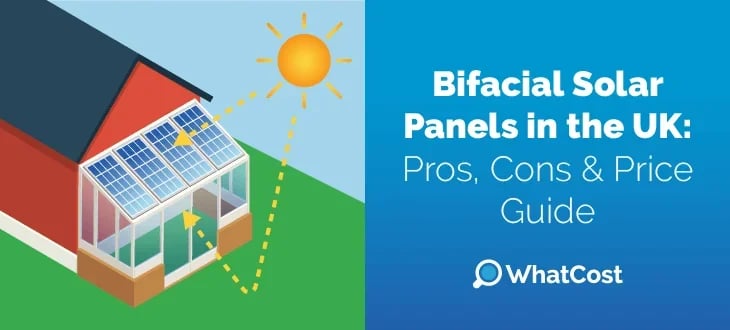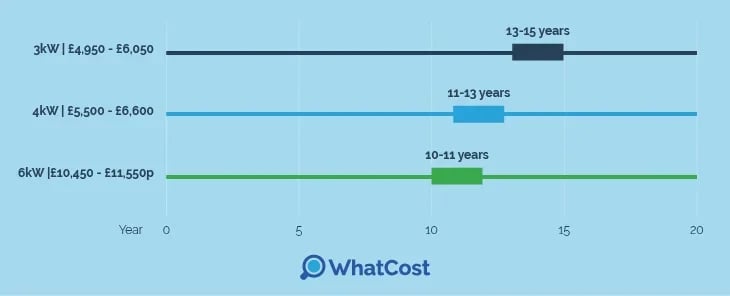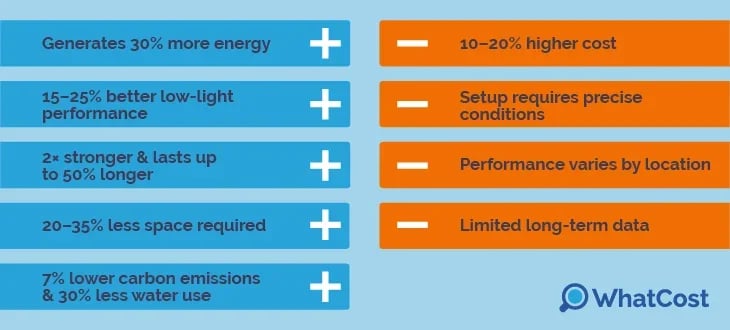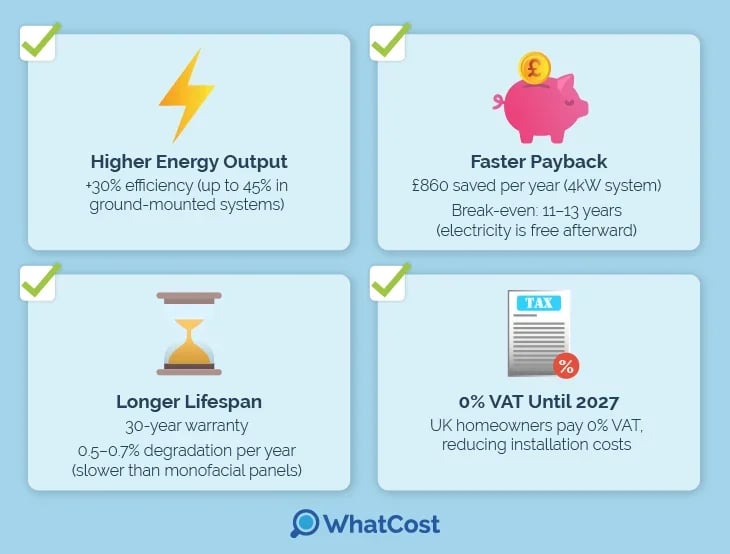Answer these simple questions and we will find you the BEST prices
Which type of solar quotes do you need?
It only takes 30 seconds
100% free with no obligation

Get up to 4 quotes by filling in only 1 quick form

Compare quotes and find yourself the best deal

Increase the value of your home by installing solar panels
- whatcost.co.uk
- Solar Panels
- Bifacial Solar Panels
Bifacial Solar Panels in the UK: Pros, Cons & Price Guide


- Bifacial solar panels grab sunlight at the front and back of the panels, converting it to electricity. Traditional monofacial panels use light on one side only.
- As of 2025, Bifacial solar panels in the UK cost an average of £5,500 - £6,600 for a 4kW system and can save about £860 on your yearly electricity bills.
- A big pro for bifacial panels is their electricity output, around 30%, using direct sunlight and reflected light. But they cost more and are harder to install.
Did you know that by 2030, according to the The International Technology Roadmap for Photovoltaic (ITRPV), around 70% of the world’s solar panels could be bifacial? It’s no wonder that in the UK, homeowners are now opting for bifacial solar panels because of their higher energy output than monofacials. If you’re wondering what bifacial solar panels are, this guide explains them, their costs, their efficiency, and their pros and cons to help you decide if they’re right for your home.
However, their specialised build and setup needs are tricky and need expert assessment to understand which is right for your home. Fortunately, we have a vast network of installers and supplier partners who can help you reach your solar adoption goals. Fill in the 30-second form below to receive up to 4 free non-commitment quotes and save hours of online research or contacting companies individually. Click below to get started!
- Quotes from local installers
- Payment by finance available
- Save up to £915 per year
It only takes 30 seconds

What are bifacial solar panels?
Bifacial solar panels are special types of solar panels that grab sunlight with the panel’s front and back instead of just the front, as used with traditional panels. This allows you to produce more electricity using the same space.
How do bifacial solar panels work?
With solar cells on both sides of the panel, a bifacial panel collects:
- Direct sunlight from above on the front side
- Reflected sunlight from surfaces like white roofs, gravel, or concrete.
Unlike conventional panels, bifacial panels use glass on both sides, eliminating the opaque plastic back sheet. This transparent or semi-transparent design lets light pass through and reflect onto the rear solar cells, thereby increasing their energy production.
The increased power output from the same system size is driving the global rise in popularity of bifacial panels, including in the UK. Experts even predict that by 2030, 70% of all solar panels could be bifacial.
Bifacial solar panels vs. traditional solar panels
Converting sunlight into electricity is what bifacial solar panels and traditional options have in common. However, they differ in design and efficiency level. Here’s how they compare:
Monofacial vs bifacial solar panels
| Feature | Bifacial | Traditional monofacial |
|---|---|---|
| Energy capture | Panel’s front and back | Panel’s front only |
| Energy efficiency | Up to 30% more electricity | Standard efficiency, 20-24% |
| Durability | Glass-on-glass design resists wear and harsh weather | Standard glass-plastic back sheet |
| Installation | Best installed over reflective areas & open spaces | Performs well in any location, including shaded areas |
| Cost | Higher upfront cost but more savings and returns | Lower upfront cost |
| Appearance | Sleek modern transparent design | Traditional opaque panels |
Bifacial solar panels perform best in open spaces where light can reflect off surfaces like light-coloured rooftops, concrete, or gravel. In the UK, they are mostly used in pastures or open areas to accommodate them, but you can also benefit from them in the right conditions. In a residential setting, you can set them up in gardens, carports, and south-facing rooftops with better reflective surfaces to help increase the output of energy.
A study by Heriot-Watt University found that bifacial solar panels installed over white pebbles in the UK produced much more energy, showing how placement affects output results.
Monofacial panels work well in all weather conditions, including cloudy and shaded areas, but bifacial panels can increase energy savings over time when installed in optimal locations.
How much do bifacial solar panels cost and what can you save?
In the UK, the 2025 cost of bifacial solar is £5,500 and £6,600 for a 4kW system fitted to a medium-sized house. It includes installation and can save about £860 per year on electricity costs. Even though they are 10% more expensive than traditional solar panel cost, they generate up to 30% more electricity from the same sunlight.
Bifacial solar panels cost in the UK 2025
| House size | Solar system size | System cost (inc. installation) |
|---|---|---|
| Small (1-2 bedrooms) | 3kW | £4,950 - £6,050 |
| Medium (2-3 bedrooms) | 4kW | £5,500 - £6,600 |
| Large (4-5 bedrooms) | 6kW | £10,450 - £11,550 |
These are estimates based on average prices and may vary based on specific installation needs and market conditions.
Bifacial solar panels savings and break-even points
You can recoup costs and lower electricity by switching to bifacial solar panels. The exact amount you save depends on how much energy you use, where your panels are installed, and the national electricity price cap.

- If you live in a small home (1-2 bedrooms), a 3kW system could save you around £570 per year, with a break-even point of 13-15 years.
- For medium-sized homes (2-3 bedrooms), expect to save about £860 per year, with a break-even period of 11-13 years with a 4kW system.
- In a large home {4-5 bedrooms), you could save up to £1,305 per year, reaching break even in just 10-11 years with a 6kW system.
The bigger your system, the faster you recover your invested money through energy savings. Once your system has paid for itself, all the electricity you generate is basically free, meaning thousands of pounds in lifetime savings.
To help you get started, we partner with some of the best solar panel suppliers across the UK who can help you find the right bifacial solar system for your home — saving hours of research and guesswork. Fill in the 30 seconds form below to get up to 4 free non-commitment quotes.
- Quotes from local installers
- Payment by finance available
- Save up to £915 per year
It only takes 30 seconds

Bifacial solar panels efficiency
In a nutshell, solar panel efficiency measures how much sunlight is converted into usable electricity. So, panels with higher efficiency can produce more power from the same sunlight.
For bifacial panels, the efficiency is even higher (up to 30% or 45%) more power than monofacial. Understanding this is essential when choosing solar panel systems, as the right one can lower electricity bills and help recoup upfront costs faster.
Let’s see what that means in terms of how much you can save.
How much more efficient are bifacial panels?
Bifacial panels can produce more electricity than monofacial panels, depending on:
- Albedo effect: This means the reflectivity of the surface beneath the panels, e.g. a light-coloured roof.
- Installation type: Ground-mounted setups benefit the most, with energy gains of up to 45%, and rooftops see increases of 10 - 22.6%
- Surrounding environment: Open spaces with reflective surfaces improve efficiency.
Energy gain by solar panel installation type
| Installation type | Energy gain (%) |
|---|---|
| Ground-mounted (optimal conditions, tracking systems) | Up to 45% more electricity |
| Ground-mounted (highly reflective surface) | Up to 30% more electricity |
| Rooftop-mounted | Up to 22.6% more electricity |
| General range | 10-30% energy boost |
- Cutting electricity costs: More energy output means you’ll need to use less grid power, which, in turn, reduces cost and saves on electricity bills.
- Faster break even period: Higher efficiency shortens the time it takes to get back the money you invested.
- More power per square metre: If you don’t have spacious roof space to add many panels, you can work with a system with higher efficiency that produces more power per square metre.
Advantages and disadvantages of bifacial solar panels

Producing between 30% and 45% more energy is one of the biggest advantages of bifacial solar panels. But they cost more and are harder to install. Below, we break down the pros and cons.
- 30% more energy production: Bifacial panels boost electricity output by up to 30%, increasing to 45% in ground-mounted systems with reflective surfaces and tracking. This makes it a powerful option for homes and large-scale solar farms.
- 15 -25% Works better in low light: The double-sided design captures 15-25% more diffused light, improving output on cloudy days and partially shaded areas.
- 2x stronger and lasts 50% longer: Glass-on-glass panels are twice as strong, as standard panels, withstand harsh weather and last up to 50% longer. They often feature 3.2mm tempered glass, reducing hail and impact damage. With up to 30-year warranties, they degrade slower and require 40% less upkeep than standard panels.
- 20 – 35% less space required: Higher energy output per square metre means 20 – 35% fewer panels are needed, saving space on rooftops and solar farms.
- 7% less carbon emission & 30% less water use: Greater efficiency lowers carbon emissions by up to 7% and reduces water use by 30%, making them a more sustainable option.
- 10 – 20% higher cost: Bifacial panels cost about 10% more than traditional panels due to extra materials like tempered glass on both sides, UV-resistant coatings, and stronger aluminium frames. Their heavier construction also increases installation costs.
- Setup requires precise conditions: Needs the right angle of around 30 degrees, height up to 47-51 inches and installed over highly reflective surfaces (70%+ albedo), making setup complex and costly.
- Performance varies by location: Energy gains depend on ground reflectivity and positioning. While some setups see 45% more output, others may gain little.
- Limited long-term data: As a newer technology, long-term results and degradation rates aren’t as well-documented as monofacial panels.
Installation and placement of bifacial solar panels
Bifacial solar panels can be installed on rooftops, ground-mounted systems, and solar canopies, but their setup differs from traditional panels to increase efficiency.
- Height and tilt: Bifacial panels work best when titled at around 30 degrees and raised at least 47-51 inches to allow reflected light to reach the back.
- Surface reflectivity: Installing bifacial solar panels over light-coloured surfaces (white gravel, metal roofs, or concrete) improves energy gain by up to 4.5% per year.
- Mounting systems: Elevated racking or single-axis tracking is required to adjust panel angles and boost results.
- Less shading: Unlike monofacial panels, shading from nearby objects reduces rear-side absorption, so open areas are preferred.
Best placement options
- Ground-mounted systems: Best for farms or large open spaces where panels can be tilted and raised to catch more reflected light.
- Rooftops: Work well on flat or light-coloured roofs with enough height to let light reach the back.
- Solar carports and canopies: Absorb sunlight from above and reflect light from cars or pavement below.
Are solar panels worth it?

Yes, bifacial solar panels are worth it. A major advantage is they produce more electricity than common monofacial options. They also last longer and can reduce your energy bill faster than traditional panels. Here’s why:
- Higher energy output: The energy they output is higher, with up to 30% efficiency and up to 45% in ground-mounted systems.
- Faster payback: You can save £860 per year and a break-even point of 11-13 years (after which your electricity is basically free) when you install a 4kW bifacial system.
- Longer lifespan: With 30-year warranties, bifacial panels degrade slower than traditional monofacial panels, providing more value over time.
- 0% on VAT until 2027: UK homeowners pay zero VAT on solar panels, reducing installation costs.
So, are solar panels worth it? Yes, bifacial types are – especially if you have an open space, light-coloured surfaces, or a high-energy demand. Their higher efficiency and energy savings help offset the higher upfront cost, making a worthy choice in the long run.
To get the most out of bifacial panels, choosing the right system size for your home is important. However, you may wonder how many solar panels do I need with a bifacial system. Since bifacial panels generate more power per panel, you may need fewer panels than traditional options, but proper placement is key to getting the most energy gains.
If investing in a solar panel system right now is costly for you, there are solar panel grants available for UK homeowners to help offset installation costs. A professional installer will need to help you get price quotes for this process.
We can connect you with up to 4 trusted solar suppliers in your area, providing accurate solar panel quotes for your home. Easily compare prices and save hours of research in the process. It takes half a minute to complete the form below; click to start!
- Quotes from local installers
- Payment by finance available
- Save up to £915 per year
It only takes 30 seconds

FAQ
Bifacial solar panels have an efficiency of 22-27%, generating 10 – 30% more electricity than monofacial panels. Energy gains can reach up to 45% in ground-mounted systems with reflective surfaces.
Bifacial solar panels produce more power, last longer, cost more and need proper placement. Monofacial panels are cheaper, easier to install, and better for shaded areas or small spaces.
Bifacial panels work best in open places with reflective surfaces, such as gardens, carports, flat rooftops, and ground-mounted systems. Installing them over light-coloured surfaces like gravel, metal, or concrete improves energy absorption.
Yes, bifacial panels have a transparent or semi-transparent back, allowing light to pass through and reflect onto the rear solar cells, increasing electricity production.

Rousanna is an SEO content writer at WhatCost with a background in digital marketing and copywriting. She creates informative, well-researched home improvement content based on practical ideas to help readers make informed decisions.
- Bifacial Solar Panels in the UK: Pros, Cons & Price Guide
- What are bifacial solar panels?
- How much do bifacial solar panels cost and what can you save?
- Bifacial solar panels efficiency
- Advantages and disadvantages of bifacial solar panels
- Installation and placement of bifacial solar panels
- Are solar panels worth it?
- FAQ
- Quotes from local installers
- Payment by finance available
- Save up to £915 per year
It only takes 30 seconds

